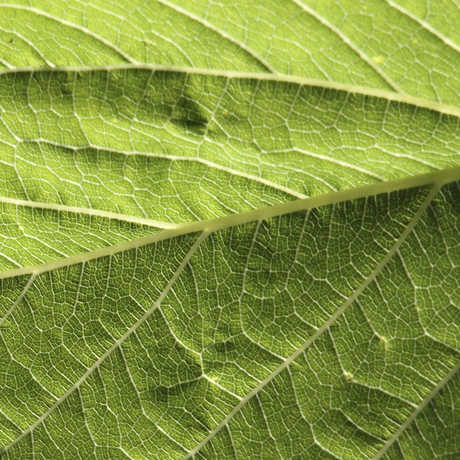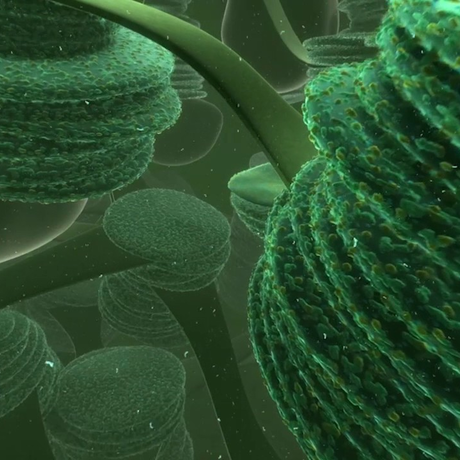
© Clinton Bauder
Seaweed, a type of algae, is more than just a primary producer: they also convert carbon dioxide into oxygen and are the foundation for many habitats in the ocean. In this activity, students will learn the parts of algae, compare them to land plants, and rotate through exploration stations to investigate seaweed close up with their different senses.
In this culinary activity, students will:
- compare and contrast land plants with kelp to review the structures and functions of parts.
- understand that algae is an important producer in aquatic environments.
- learn how kelp is adapted to live along the California Coast.
- use multiple senses (sight, smell, touch, and taste!) to explore real seaweed samples.
- Visual aids of giant kelp and other algae
- We have included some here, but there are many more on the internet
- Teacher tip: project these onto a screen if possible
- Seaweed Salad Recipe sheet (one per student)
- Sensational Seaweed! worksheet (one per student)
For the exploration stations:
- Samples of seaweed such as arame, wakame, konbu, hijiki; or, a mixed bag (kaisou sarada)
- Plastic cups or petri dishes (3-4 per station to hold seaweed samples)
- Water
- Paper towels
- Colored pencils
- Dixie cups (one per student)
- Compostable forks or set of chopsticks (one per student)
- Microscopes with petri dishes or slides (optional for seeing station)
For preparing the Seaweed Salad:
- 1 bag of dried wakame (or the seaweed of your choice!)
- Rice vinegar
- Soy sauce
- Sugar
- Sesame seeds
- Large bowl for salad
- Large strainer for salad
- Small bowl for dressing
- Tablespoon
- Fork for stirring
- kelp: large brown algae that grow in the shallow regions that extend over the continental shelf where light can penetrate the water
- photosynthesis: the process in which organisms use water along with sunlight and carbon dioxide to make sugar
- algae: a general term for microscopic or larger aquatic plants that use the sun’s energy to make food. They differ from trees, bushes, and other flowering plants because they do not have true roots, stems, and leaves.
- Make the edible wakame salad the morning of the lesson. Use the directions from the Seaweed Salad Recipe sheet, which can be cut into fourths to distribute to students to take home to their families. Adjust amounts as necessary for class size and to taste. To serve 20-30 students with more than a taste, but less than a serving, you’ll need:
- Dried wakame seaweed: 3 ounces (85 grams)
- Sesame seeds: 4 tbsp
- Rice vinegar: 12 tbsp
- Soy sauce: 6 tbsp
- Sugar: 3 tbsp
- Photocopy the Sensational Seaweed worksheet for each student. Use microscopes if you have them; if not, the students can certainly investigate with the naked eye. A worksheet is available for both cases - with a microscope and without.
- Soak seaweed in small plastic cups for at least 15 min to hydrate. You’ll need less than you think! Use either a mix, or purchase different kinds.
- Set up stations in the room as you see fit for rotating groups through tasks:
- Seeing: Place a sample of each seaweed on its own dish or in a plastic cup.
- Microscopes: Prepare a scope for each type of seaweed. Cut a very small piece, place on a petri dish or slide, and set so the view is in focus.
- Tasting: Prepare small dixie cups of the wakame salad for each student. For utensils, you can use forks or chopsticks.
- Touching & Smelling: Place a sample of each seaweed on its own dish or in a plastic cup.
- My Algae Haiku: Set up a comfortable area to inspire unbridled creativity!
- Draw a picture of kelp on the board without the parts labeled.
- Ask students if they have ever been to the beach. If so, have they encountered clumps of slimy seaweed on the sand? In California, this seaweed is often giant kelp, which is a type of algae. Algae are like the plants of the sea. What do land plants need to survive? (sunlight, nutrients, carbon dioxide, water…) Depending on the age level of your students, review the chemical equation for photosynthesis.
- Note that kelp is similar to a land plant in terms of its needs and its ability to photosynthesize. However, kelp differs from plants because it doesn’t have the same body parts, and it doesn’t have a system of pipes to transport all of the sugar, water, and gases around.
- Label the diagram as you introduce the parts of the kelp plant. Describe the functions of each, and how they might be well-adapted to living off our rough coastal waters. (see diagram on page 3)
- Holdfast: keeps the kelp tightly anchored to the ground, so it won’t be pushed away by the waves; must glue on to a rock or hard substrate, not soft, sifting sand; different from roots because it doesn’t actually grab nutrients from the ground --instead, nutrients can enter any part of the plant, all of which can photosynthesize.
- Stipe: long like a stem, with room for many “branches”, but doesn’t have tubes and “sap”.
- Blades: analogous to leaves; long and broad in order to collect as much sunlight as possible for photosynthesis.
- Bladders: air sacs to hold the plant up; the stipe isn’t a strong support, and the blades need to reach the water’s surface to get sunlight, so these air bubbles make the top of the plant float.
- Consider making a simple chart contrasting giant kelp with a giant redwood, showing how kelp does not contain true roots, stems, and leaves, but has parts that sometimes – but not always -- perform the same functions.
- Showcase the variety of algae types using the visuals. Have students notice some differences.
- Brainstorm what roles algae plays in its environment (e.g., a producer of oxygen, a habitat for organisms, and food for herbivores).
- Explain that students will now get a chance to experience algae firsthand. Hand out the “Sensational Seaweed” worksheet and explain how the station rotations will work. Students can pick one type of seaweed to focus on at each station. If they finish their station’s task early, they should work on these “I Wonder” and “Algae Haiku” boxes:
- I wonder: use this space to list any questions that come to mind, such as “I wonder where this algae lives.” or “I wonder what makes it slimy.”
- Algae Haiku: Compose a short poem inspired by your investigation. Like a traditional haiku, the first line is 5 syllables, the second line 7, and the third line 5. For example, “So soft and slimy, tasting both salty and sweet, my algae is cool!”
- Aim for about 7 minutes per station. As groups rotate, be sure to give “2-minute warnings” to prepare kids to complete their assignment in time.
- Have students share out what they discovered from their investigations. How did the samples of algae differ from each other? (color, texture, thickness, arrangement of cells, taste) Does anyone want to share a poem, or showcase their illustrations?
- Discuss the following questions with your students:
- Why do you think kelp is considered a producer, just like plants? (Kelp is a type of algae. All algae photosynthesize, producing their own food)
- Name one of the special adaptations that help kelp survive in its turbulent environment. (it has a holdfast that keeps it anchored to the ocean floor and air sacs to keep the blades close to the surface to photosynthesize)
- Can you think of organisms that eat kelp? (sea urchins, sea slugs, decorator crabs, me)
- Besides food, discuss ways humans use kelp. (ice cream, makeup, toothpaste)
- Pass out the recipe cards so the kids can encourage their families to try to eat seaweed!
Kelp is classified as brown algae and is also referred to as seaweed. Seaweeds are marine algae that are separated into three groups; brown, green, and red algae. They all need salty water and the energy of the sun to make their own food. Therefore, they live in the shallow, rocky intertidal zone of the ocean to be able to photosynthesize. Sunlight is captured by blades of the kelp and a chemical reaction involving water, carbon dioxide, and sunlight takes place producing sugars and oxygen. Kelp releases the oxygen into the water and the sugar is used for food. See the formula for photosynthesis below:
6H2O + 6CO2 ----------> C6H12O6+ 6O2
Kelp differs from flowering plants in many ways. They attach themselves to the rocky bottom using their holdfasts and grow tall, reaching for the sun. The intertidal zone is incredibly turbulent due to the crashing waves so the holdfast secures the kelp to the bottom. The blades of the plant reach the surface of the water because of air filled sacs below them that keep them afloat. Kelp needs to be submerged in cool, nutrient-rich water. If kelp is out of the water and is exposed to too much sunlight, the blades will dry out and the plant will die.
Found along the west coast of California, kelp forests provide shelter for numerous organisms in the cold waters of the Pacific Ocean. This habitat also serves as a nursery for juvenile fish and invertebrates. Kelp also produces oxygen and is a major food source for fish and invertebrates such as sea urchins and sea slugs. Most seaweed is highly nutritious and is also eaten by many people all over the world.
Did you know? Kelp is also harvested from the ocean for commercial use (after all, it can grow 2 feet per day, up to 150 feet tall!). You can find a component of kelp in ice cream, toothpaste, cosmetics, salad dressing, and much more! Look on the ingredients label for “algin” or “carrageenan”.
Grade Three
Life Sciences
3a. Students know plants and animals have structures that serve different functions in growth, survival, and reproduction.
Grade Four
Life Sciences
2a. Students know plants are the primary source of matter and energy entering most food chains.
Grade Five
Life Sciences
2a. Students know many multicellular organisms have specialized structures to support
the transport of materials.
2f. Students know plants use carbon dioxide (CO2) and energy from sunlight to build molecules of sugar and release oxygen.
Grade Six
Life Sciences
5a. Students know energy entering ecosystems as sunlight is transferred by producers into chemical energy through photosynthesis and then from organism to organism through food webs.
Science and Engineering Practices
- Asking Questions and Defining Problems: Ask questions that arise from careful observation of phenomena to clarify and/or seek additional information.
- Planning and Carrying Out Investigations: Make observations to produce data to serve as the basis for evidence for an explanation of a phenomenon.
Disciplinary Core Ideas
- LS1.A: Structure and Function: Plants and animals have both internal and external structures that serve various functions in growth, survival, behavior, and reproduction.
- LS1.C: Organization for Matter and Energy Flow in Organisms: Plants acquire their material for growth chiefly from air and water.
Cross-Cutting Concepts
- Structure and Function: Substructures have shapes and parts that serve functions.
- Patterns: Macroscopic patterns are related to the nature of microscopic and atomic-level structure.
Related Performance Expectations
- 4-LS1-1: Construct an argument that plants and animals have internal and external structures that function to support survival, growth, behavior, and reproduction.
- 5-LS1-1: Support an argument that plants get the materials they need for growth chiefly from air and water.
- MS-LS1-6: Construct a scientific explanation based on evidence for the role of photosynthesis in the cycling of matter and flow of energy into and out of organisms.


